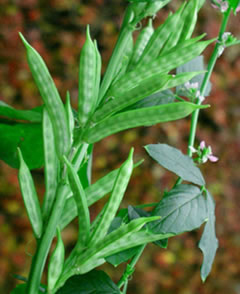 Economics 101: supply and demand. The more supply in the market, the price of a product drops. The more demand, prices rise. Demand leads to sales, which reduces supply and forces prices higher and higher until either 1) supply runs out or 2) prices drop demand.
Economics 101: supply and demand. The more supply in the market, the price of a product drops. The more demand, prices rise. Demand leads to sales, which reduces supply and forces prices higher and higher until either 1) supply runs out or 2) prices drop demand.
This isn’t a theoretical or arcane concept. Here’s how that process played out just this week.
Last month, Reuters told the story of an unexpected economic windfall for farmers in India’s northern deserts. The seeds from guar beans, which look like bean/pea hybrids and for which the region is the primary source, can be processed to create a powdery gum. This gum is used in a variety of products: ice cream, sauces — and the liquid employed in hydraulic fracturing. Guar gum is an emulsifier, a thickener. In the fracking process, it’s generally combined with kerosene to create the fluid forced deep into shale deposits. (This video shows how the compound is made.)
As hydraulic fracturing has exploded (figuratively!) (so far!) in America, so has demand for guar beans. Between 2011 and 2012, prices for the beans shot up tenfold, prompting Indian authorities to investigate how the market was operating. The farmers had fewer concerns:
“Guar has changed my life,” said Shivlal, a guar farmer who made 300,000 rupees ($5,400) — five times more than his average seasonal income — from selling the beans he planted on five acres (two hectares) of sandy soil in Rajasthan state.
“Now, I have a concrete house and a color TV. Next season I will even try to grow guar on the roof.”
Demand and prices spiked. Until the market reached the point at which the demand cracks.
Earlier this week, Halliburton announced lower-than-expected profits for the second quarter of the year due to a shortage of Indian guar beans.
The giant oilfields services company attributed the bigger decline in its profit margins to a shortage of guar beans in India. … Halliburton has said the guar system can now account for as much as 30 percent of the overall fracking price.
“They’ve been passing along the cost incrementally, but because there’s been such a burst in pricing, it’s been hard to keep up with,” said Grant Fox, an analyst at Sterne, Agee & Leach.
It’s not clear what happens next. The Indian farmers — and the company Vikas WSP, which has been passing out free guar seeds in an effort to increase supply more rapidly — clearly hope to maintain the bean’s popularity and price. Halliburton, meanwhile, is marketing CleanStim, a non-guar-based fracking fluid “made with ingredients sourced from the food industry.” (Please read the footnote provided: “Even though all the ingredients are acquired from food suppliers, the CleanStim fluid system should not be considered edible.” Good tip, guys!)
In the world’s most advanced economy, one in which transactions hinge on microsecond gaps between online systems, a massive, multi-billion dollar company still gets tripped up on how fast farmers in India can grow beans.
Economic fundamentals at work.
* Alternate title — Guar: What is it good for?



